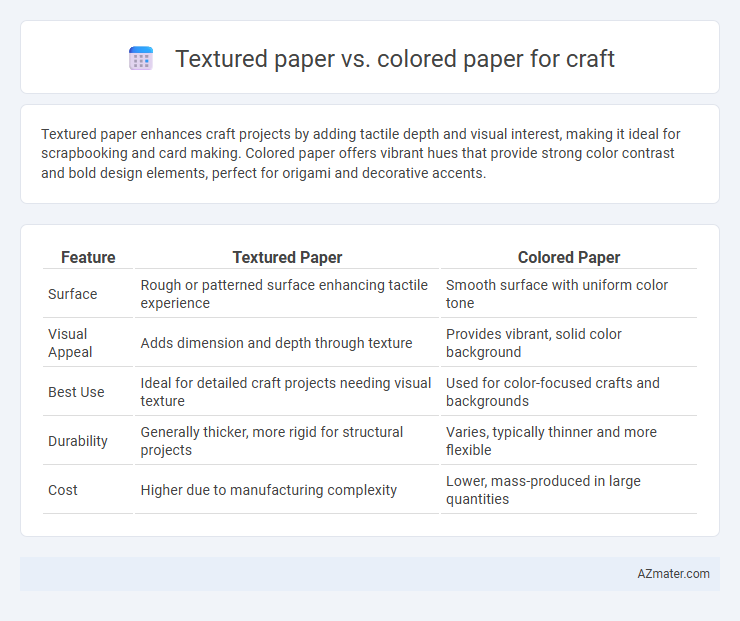Textured paper enhances craft projects by adding tactile depth and visual interest, making it ideal for scrapbooking and card making. Colored paper offers vibrant hues that provide strong color contrast and bold design elements, perfect for origami and decorative accents.
Table of Comparison
| Feature | Textured Paper | Colored Paper |
|---|---|---|
| Surface | Rough or patterned surface enhancing tactile experience | Smooth surface with uniform color tone |
| Visual Appeal | Adds dimension and depth through texture | Provides vibrant, solid color background |
| Best Use | Ideal for detailed craft projects needing visual texture | Used for color-focused crafts and backgrounds |
| Durability | Generally thicker, more rigid for structural projects | Varies, typically thinner and more flexible |
| Cost | Higher due to manufacturing complexity | Lower, mass-produced in large quantities |
Understanding Textured Paper: Features and Uses
Textured paper offers a tactile surface with unique patterns such as linen, embossed, or laid finishes, enhancing the visual and sensory appeal of craft projects. Its varied textures provide depth and dimension, making it ideal for scrapbooking, card making, and mixed media art where surface detail is crucial. Unlike colored paper, which primarily adds hue, textured paper contributes both aesthetic richness and a distinct feel, elevating the overall artistic expression.
What is Colored Paper? Key Characteristics
Colored paper is a type of craft material that features a uniform hue throughout, offering vibrant and consistent coloration ideal for projects requiring precise color matching. It is typically smooth or lightly finished, allowing for easy cutting, folding, and gluing, making it versatile for various craft applications such as scrapbooking, card making, and origami. Unlike textured paper, colored paper prioritizes color consistency over surface variation, providing a flat, even base that enhances visual clarity and crispness in detailed designs.
Visual Appeal: Texture vs. Color in Craft Projects
Textured paper enhances craft projects by adding depth and tactile interest, creating a dynamic visual appeal that colored paper alone cannot achieve. Colored paper provides vibrant hues that set the mood and theme, while textured varieties introduce dimension and complexity through raised patterns or embossed finishes. Combining texture with color maximizes the aesthetic impact, making crafts more visually engaging and unique.
Durability and Strength: Comparing Paper Types
Textured paper offers enhanced durability due to its thicker fibers and embossed surface, making it ideal for crafts requiring a robust finish. Colored paper, while visually appealing, tends to be thinner and less resistant to tearing or folding under stress. For projects demanding strength and longevity, textured paper outperforms colored paper by maintaining structural integrity over time.
Creative Applications for Textured Paper
Textured paper enhances craft projects by adding depth and tactile interest, making it ideal for scrapbooking, card-making, and mixed media art. Its raised patterns and varied surfaces create unique visual effects that plain colored paper cannot achieve, encouraging more creative expression. Artists prefer textured paper for techniques like embossing, stamping, and layering, which result in more dynamic and visually appealing crafts.
Popular Craft Ideas Using Colored Paper
Colored paper is popular for vibrant origami, paper flowers, and scrapbooking, adding bright, consistent hues that enhance visual appeal. Textured paper, while offering tactile interest and depth, is often reserved for specialty projects like invitations or mixed media crafts where surface feel is crucial. For most craft ideas, colored paper provides versatility and ease of use, making it a favored choice among crafters.
Ease of Cutting, Folding, and Shaping
Textured paper offers a unique tactile surface that can add depth to crafts but may require more effort to cut precisely due to its uneven fibers. Colored paper, typically smoother and thinner, provides easier cutting and cleaner folds, making it ideal for intricate shapes and detailed designs. While textured paper excels in adding a dimensional effect, colored paper is preferred for projects demanding precise shaping and quick manipulation.
Best Paper Choice for Children’s Crafts
Textured paper offers a tactile experience that enhances sensory development and creativity in children's crafts, making it ideal for projects involving collage or mixed media. Colored paper provides vibrant, ready-to-use hues that simplify color selection and inspire imaginative designs, suitable for cutting, folding, and drawing activities. For the best paper choice, combining both textured and colored options supports diverse craft techniques and keeps children engaged through varied sensory input.
Cost Comparison: Textured vs Colored Paper
Textured paper generally costs more than colored paper due to the additional processing required to create its unique surface patterns. Colored paper, often produced in bulk with straightforward dyes, tends to be more affordable for large-scale craft projects. When budgeting, crafters should consider the price difference in relation to the desired aesthetic and project complexity.
Choosing the Right Paper for Your Next Craft Project
Textured paper enhances craft projects by adding depth and tactile interest, making it ideal for scrapbooking, card making, and mixed media art. Colored paper offers vibrant hues that can complement or contrast elements, perfect for origami, paper flowers, and layered designs. Selecting the right paper depends on your project's visual goals, desired durability, and the types of adhesives or tools you plan to use.

Infographic: Textured paper vs Colored paper for Craft
 azmater.com
azmater.com